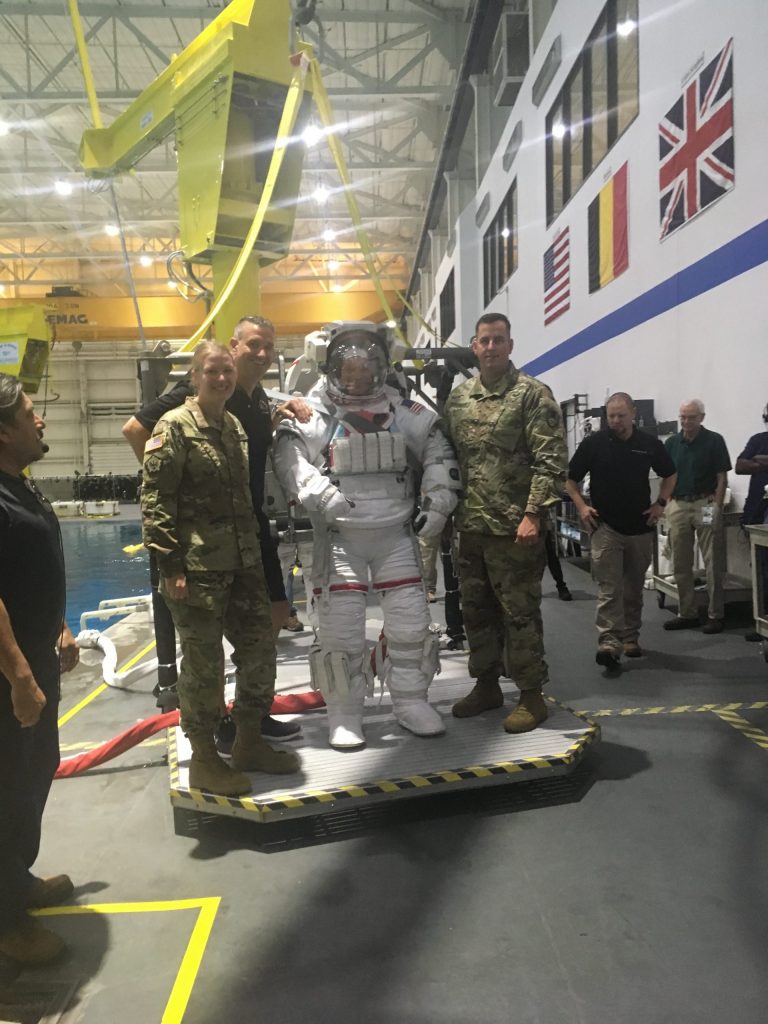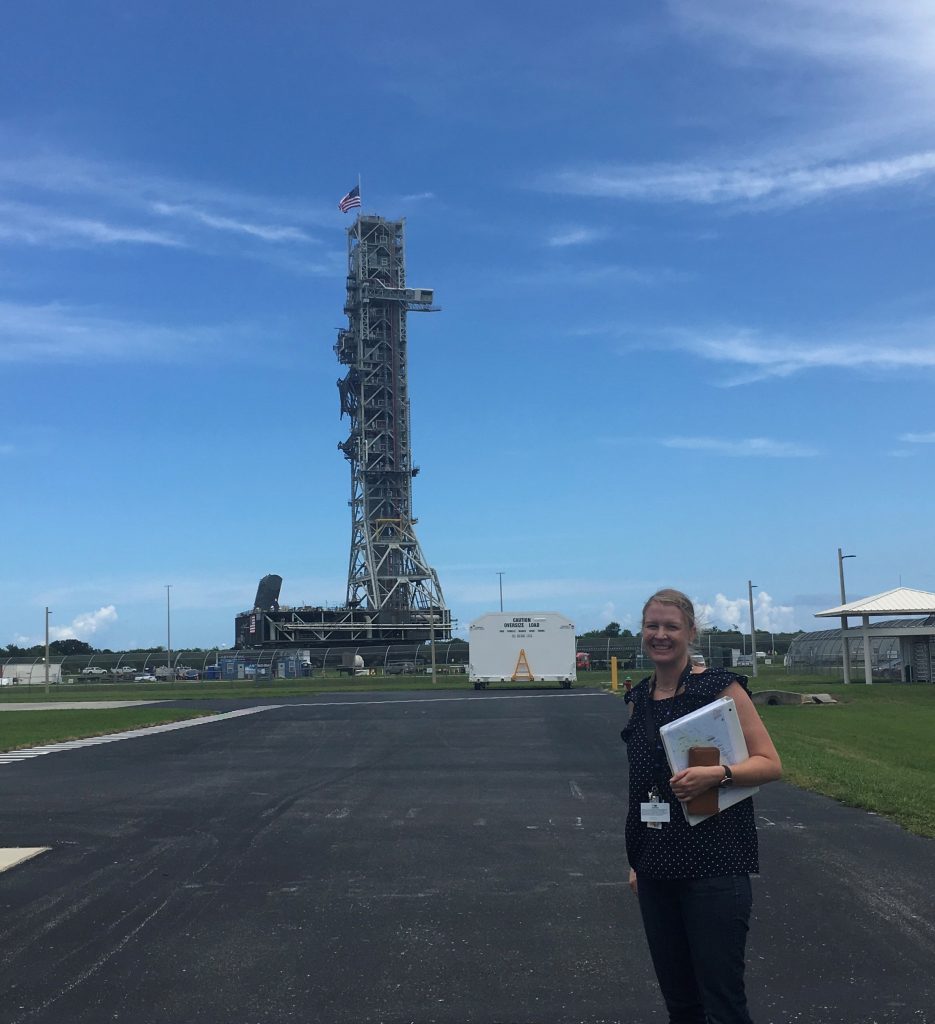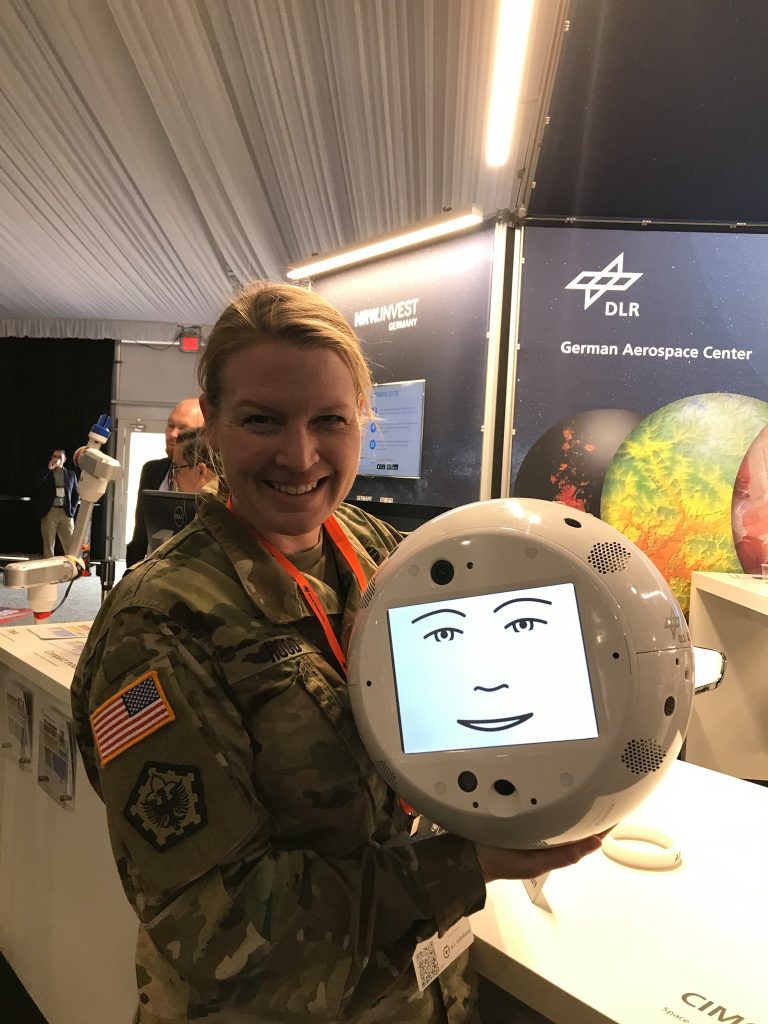
HOUSTON, DO YOU COPY?: Morgan, left, Springer, center, and Hood visited the Mission Control Center in Houston.
By Jacqueline M. Hames
“STEM is a full-contact sport,” said Maj. Karoline Hood, engineer and space operations officer. She told her math students at the U.S. Military Academy at West Point that very thing when she was teaching—STEM is something she’s passionate about.
And that passion has seen her through 14 years with the Army. “I’ve had pretty much all the kind of standard Army jobs—platoon leader in Iraq, company commander in Afghanistan, battalion S-4 [logistics] job,” she said. “I’ve also had some pretty unique assignments as well.” She’s worked with the U.S. Army Corps of Engineers Seattle District and is now a project engineer stationed at the Army NASA Detachment at the Johnson Space Center in Houston. She considers her job at the space center one of the more unique roles she’s had, in that she helps support human space flight as a space operations officer.
Functional Area 40—space operations—is part of the Army’s larger space capabilities, and these capabilities are more extensive than you think. The Army is the largest user of space-based capabilities in DOD. Space-based GPS, communications, weather and intelligence collection platforms—like satellites—are critical for maintaining situational awareness and to protect and sustain the force. Space is “ingrained into every aspect of Army ground operation,” according to the U.S. Army Space and Missile Defense Command (USASMDC), from weapons to maneuverability. USASMDC is responsible for most of the Army space enterprise—including the development of space operations officers and providing NASA with astronauts. It is home, specifically, to the Army Space Personnel Development Office (ASPDO) in Colorado Springs, Colorado—where the space operations officers are trained.

DRESS REHEARSAL: Maj. Karoline Hood, left, visited the Neutral Buoyancy Lab with Army astronaut Col. Drew Morgan, second from left, and fellow space operations officer Lt. Col. Adam Springer, right. Morgan was preparing to practice a simulated extravehicular activity, or spacewalk. (Photos courtesy of Maj. Karoline Hood)
“We are a pretty small group,” Hood said. “The basic rule of an FA40 officer is to utilize and integrate space capabilities with terrestrial-, sea-, air- and high altitude-based systems owned and operated by the DOD, the [intelligence] community, civilian agencies and commercial partners.” In other words, space operations officers figure out what the warfighter’s mission is and then integrate space capabilities within that mission, she explained.
As a project engineer, Hood facilitates and provides technical reviews on space systems and hardware—including preparing spacecraft for flight—and supports launching and landings. That means she works closely with companies like SpaceX and Boeing to ensure vehicle safety. Hood ensures companies are meeting contract requirements, identifying variances in those requirements and getting them approved, and she is responsible for the overall certification of a spacecraft in all phases of flight. “One of the vehicles I am working on right now is going to be launching astronauts in the spring timeframe, and it’s a SpaceX Crew Dragon vehicle that has already flown,” she said. “We’re in the process of refurbishing it, and so one of my jobs is following it through the refurbishment process.” All transportation vehicles in the Commercial Crew Program, like the Crew Dragon, must be certified to meet NASA requirements.

LAUNCH BREAK: Hood toured the Kennedy Space Center in Florida, where she saw the mobile launcher platform, which is used to support large multistage space vehicles. The space vehicle is assembled at the vehicle assembly building and then transported to the launch pad.
Preparing a spacecraft for flight usually culminates with a crew equipment integration test, Hood explained, during which the crew validates all the different interfaces, like seat rotation, hatches and spacesuit umbilical connections. During such a test, she also ensures astronauts are also able to inspect the vehicle before it is launched and uses their feedback to help improve the capsule. For example, they are required to ensure there are no sharp edges that could puncture a pressurized spacesuit, or to add Velcro in certain places for placement of various emergency cue cards, she said.
In February 2019, Hood conducted unassisted crew egress rescue testing. The NASA-led test used a mock capsule, called a boiler plate, and took place in the Neutral Buoyancy Lab at the Johnson Space Center. The crew practiced escaping the vehicle onto a life raft during a water landing. Hood and her team validated procedures and tested radios, personal locator beacons and life raft deployment—all to ensure the vehicle is safe.
Later that year, Hood assisted Boeing with the landing and recovery operations during the December orbital flight test of the Boeing CST-100 Starliner vehicle. The Boeing-led test sent the Starliner vehicle into space—launched from the Kennedy Space Center in Florida—and then landed it a few days later in White Sands, New Mexico, Hood said. She was on site to help with post-landing recovery operations.
Space operations officers can have a wide range of jobs. They are integrated into the planning and operations positions at all organizational levels that, according to ASPDO, “influence, shape, research and develop, and acquire space-related capabilities.”
Getting to space isn’t an easy task, and once you get there, everything about it is trying to kill you. So, before you look up, remember to look around—the task begins here, with people just like Hood.

SIRI, BUT FOR SPACE: Hood attended the Space Symposium in Colorado Springs, where she interacted with a mockup of “CIMON,” the Crew Interactive Mobile Companion. CIMON is an AI robot that has been used on the International Space Station.
Read the full article in the Winter 2021 issue of Army AL&T magazine.
Subscribe to Army AL&T News – the premier online news source for the Army Acquisition Workforce. ![]() Subscribe
Subscribe


